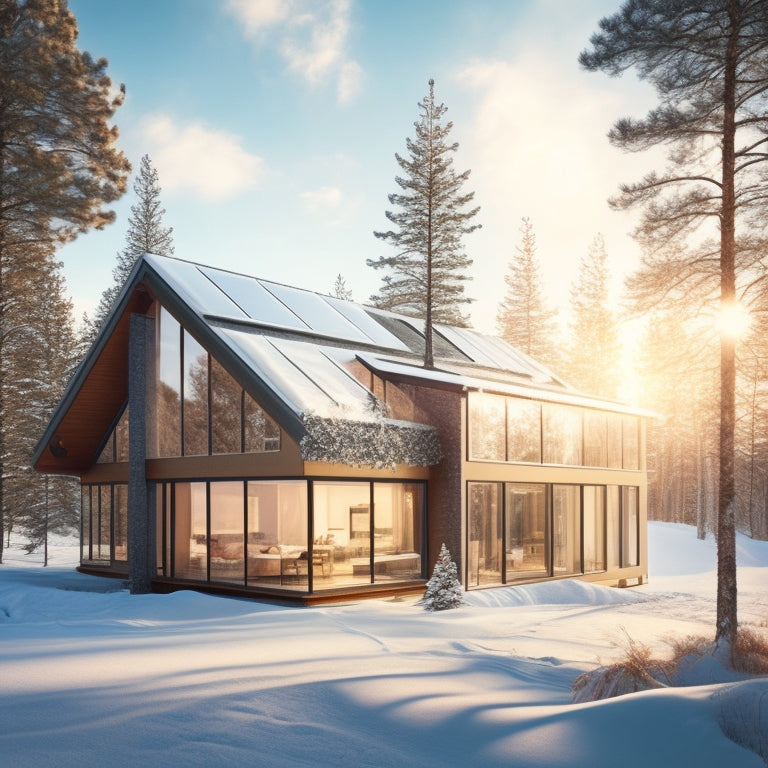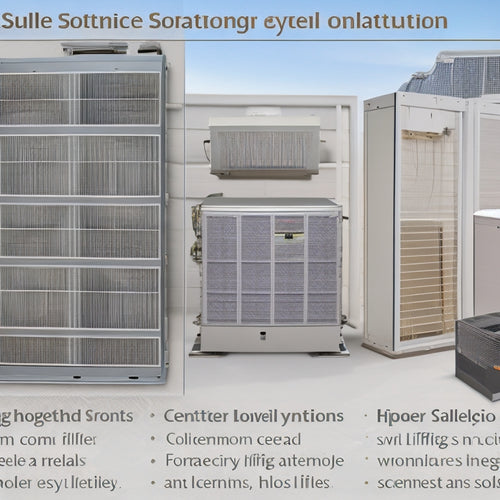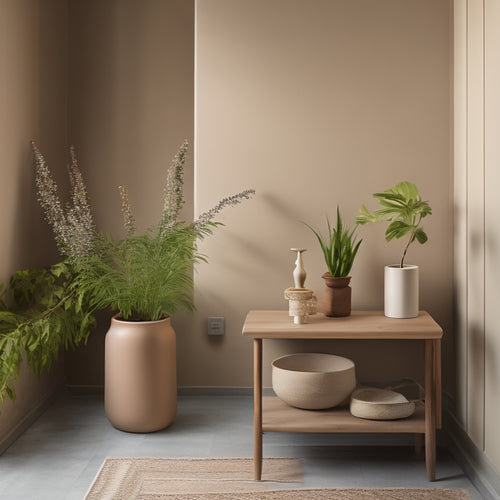
Why Position Windows for Optimal Passive Solar Gain?
Share
By positioning windows for ideal passive solar gain, you'll utilize free energy from the sun to warm your home in winter and reduce your heating bills. In summer, you'll minimize overheating and cooling costs by strategically shading those windows. Properly angled south-facing windows capture winter sunlight, while east- and west-facing windows require materials with lower heat gain coefficients. As you balance insulation and ventilation, you'll enhance natural light, improve air circulation, and create a comfortable living space. By maximizing window orientation, you'll access the full potential of passive solar gain, and the benefits will only get brighter from here.
Key Takeaways
- Positioning windows for optimal passive solar gain maximizes natural light and heat, reducing the need for artificial lighting and heating.
- South-facing windows capture optimal sunlight during winter months, providing radiant energy utilization and reducing heating expenses.
- Angling windows between 15° and 25° off true south optimizes winter sun exposure, reducing heat loss and increasing energy efficiency.
- Proper window orientation and placement can lead to improved sleep quality, enhanced mood, and increased energy levels due to increased natural light.
- Effective window placement and orientation reduce the need for fossil fuels, lowering carbon footprint and contributing to a more sustainable environment.
Benefiting From Natural Light
Positioning your windows to maximize natural light can greatly impact your home's energy efficiency and overall ambiance. By doing so, you'll create a space that not only looks and feels more inviting but also supports your well-being.
Natural light has a significant effect on mood enhancement, as it stimulates the production of serotonin, a hormone that regulates your mood. Furthermore, it can increase your energy levels and even improve your sleep quality.
Regular maintenance of your solar panels, such as monitoring and preventing battery failure, can also contribute to an energy-efficient home.
Reducing Winter Heating Costs
You'll want to position your windows to maximize solar radiation during winter months, allowing natural heat to warm your space.
Proper insulation and orientation of your windows are also essential to reducing heat loss and keeping the cold out.
By leveraging renewable energy solutions and investing in energy-efficient systems, you can further reduce your reliance on fossil fuels and lower your carbon footprint.
Maximizing Solar Radiation
As winter approaches, the low-angled sun casts a shorter, more oblique path across your windows, presenting an opportunity to employ its radiant energy and reduce your heating costs.
To maximize solar radiation, consider the solar angles and window materials. South-facing windows receive the most direct sunlight, so use materials with high solar heat gain coefficients, like double-glazed windows with low-e coatings. These allow sunlight to pass through while keeping heat in.
Additionally, evaluating available roof or ground space for ideal solar panel arrangement site assessment can further enhance energy production.
East- and west-facing windows receive indirect sunlight, so use materials with lower coefficients to avoid overheating.
Insulation and Orientation
Optimizing your home's insulation and orientation is vital for reducing winter heating costs, especially when complemented with strategic window placement.
Proper insulation prevents heat loss, while a well-oriented home utilizes natural heat from the sun. In a passive solar design, thermal mass elements like concrete or brick absorb and release heat, regulating your home's temperature.
By incorporating renewable energy solutions, such as solar panels, you can further reduce your reliance on fossil fuels and lower your carbon footprint.
Confirm your home is airtight to prevent air leakage, which can negate the benefits of insulation and orientation. By sealing gaps and cracks, you'll retain the heat you need and reduce your reliance on heating systems.
With these elements in place, you'll be well on your way to a cozy, energy-efficient home that gives you the freedom to enjoy the winter season without breaking the bank.
Window Treatment Strategies
Windows, a critical component in passive solar design, play a significant role in reducing winter heating costs. By incorporating the right window treatment strategies, you can maximize the benefits of passive solar gain while minimizing heat loss.
To further enhance energy efficiency, consider selecting energy-efficient charging equipment high energy ratings for your solar EV charging station, and guarantee proper solar panel array design with a strategic orientation and tilt between 25-35 degrees.
- Apply window film for UV protection and thermal insulation
- Hang thermal curtains or decorative shades to reduce heat loss and add aesthetic value
- Install energy-efficient blinds for peak light control and insulation
- Integrate acoustic treatments and privacy screens for a comfortable living space
- Consider layering techniques and maintenance tips to verify your window treatments work in harmony with your passive solar design
Harnessing Summer Shade
Most homes receive direct sunlight for at least six hours a day during the summer months, which can lead to overheating and increased cooling costs.
To avoid this, you can utilize summer shade by incorporating shading techniques into your window design. Strategically place vegetation, such as trees or vines, to block direct sunlight during peak hours. This will reduce solar heat gain and promote summer comfort.
Additionally, consider incorporating thermal mass elements, like concrete or brick, into your outdoor living spaces to absorb and release heat slowly. By doing so, you'll reduce your energy efficiency costs and create a more comfortable living space.
Effective shading techniques can also improve air circulation and enhance climate adaptation, giving you more freedom to enjoy your outdoor spaces without worrying about the heat.
Optimizing Window Orientation
When optimizing window orientation for passive solar gain, you'll want to prioritize south-facing windows, as they receive the most direct sunlight during winter months.
To maximize gain, angles between 15° and 25° off true south are ideal, allowing for optimal winter sun exposure while minimizing summer sun.
South-Facing Window Priority
Your south-facing windows hold the key to releasing ideal passive solar gain, as they're strategically positioned to employ the sun's energy. By prioritizing these windows, you can maximize energy efficiency and reduce your reliance on artificial lighting.
-
Consider window specifications that allow for optimal sunlight exposure, such as larger windows with minimal framing to reduce glare.
-
Incorporate thermal mass materials, like concrete or brick, to absorb and release heat as needed.
-
Implement passive design principles, like overhangs or awnings, to regulate seasonal adjustments in sunlight exposure.
-
Balance aesthetic considerations, like window placement and size, with privacy solutions, such as window film or screens.
-
Integrate ventilation strategies, like operable windows or clerestory windows, to maintain a comfortable indoor climate.
Angle for Maximum Gain
Beyond south-facing windows, optimizing their orientation is crucial to employ maximum passive solar gain.
To achieve this, you'll need to take into account the solar angles specific to your location. During winter, the sun is lower in the sky, so a slightly lower window angle is ideal for maximum gain.
In contrast, during summer, the sun is higher, and a steeper angle is needed to minimize gain and prevent overheating.
By adjusting the window angle according to the sun's path, you can enhance gain optimization and guarantee energy efficiency.
This attention to detail in passive design allows for better thermal variation, increased light penetration, and a more comfortable living space.
Shading Device Considerations
By enhancing window orientation, you've taken a significant step towards utilizing passive solar gain.
However, it's equally important to take into account shading device considerations to maximize the benefits. Shading devices can help reduce glare, minimize overheating, and enhance natural light diffusion.
- Choose shading materials that allow for seasonal adjustments to accommodate changing sun angles.
- Integrate shading design with exterior screens and building elements to create a seamless look.
- Think about using light-diffusing materials to soften harsh sunlight and reduce glare.
- Incorporate passive cooling strategies into your shading design to minimize the need for mechanical cooling systems.
- Balance shading device placement with window orientation to achieve the best passive solar gain.
Balancing Insulation and Ventilation
In a well-insulated building envelope, the delicate dance between insulation and ventilation takes center stage. You must strike a balance to guarantee ideal passive solar gain.
Insulation prevents heat loss, but if overdone, it can lead to stagnant air and moisture buildup. On the other hand, ventilation introduces fresh air, but if not controlled, it can negate insulation efforts.
Drafting guidelines dictate that you minimize thermal bridging by using continuous insulation and air-tight construction. Effective ventilation strategies, such as whole-house fans or clerestory windows, promote air circulation without compromising insulation.
Minimizing Energy Consumption
Across the range of building design, positioning windows for ideal passive solar gain revolves around minimizing energy consumption. By doing so, you can reduce your reliance on artificial lighting and heating, creating a more sustainable and energy-efficient space.
To achieve this, consider the following strategies:
-
Orient windows towards the south: This allows for maximum solar gain during winter months, reducing the need for artificial heating.
-
Use energy-efficient materials: Incorporate materials with high thermal mass, such as concrete or brick, to absorb and release heat as needed.
-
Incorporate passive design: Design your building to take advantage of natural ventilation and insulation, reducing the need for mechanical systems.
-
Optimize window size and placement: Balance window size and placement to maximize natural light and heat while minimizing heat loss.
-
Consider shading devices: Install overhangs or awnings to block direct sunlight during summer months, reducing cooling needs.
Enhancing Daylighting Strategies
Through the strategic placement of windows and skylights, you can harness natural light to illuminate your space, reducing the need for artificial lighting and its associated energy consumption. By optimizing daylighting strategies, you can create a more comfortable, energy-efficient, and visually appealing environment.
| Daylighting Strategy | Benefits | Design Considerations |
|---|---|---|
| Light Diffusion | Reduces glare, enhances thermal comfort | Window materials, color choices |
| Glare Reduction | Minimizes discomfort, improves aesthetic appeal | Window orientation, overhangs |
| Seasonal Adjustments | Optimizes natural light throughout the year | Space planning, window placement |
| Aesthetic Appeal | Enhances visual appeal, promotes freedom | Color schemes, window design |
Improving Overall Comfort Levels
Step into a space that wraps you in comfort, where the interplay of natural light, temperature, and air quality converges to create a sense of well-being.
By positioning windows for ideal passive solar gain, you can improve overall comfort levels. This is achieved by:
- Maintaining thermal comfort through precise indoor temperature control
- Enhancing air circulation to reduce humidity and prevent stagnation
- Making seasonal adjustments to window placement for optimal light diffusion
- Creating comfort zones that respond to your body's natural rhythms
- Increasing energy efficiency through passive design, reducing the need for artificial heating and cooling
Frequently Asked Questions
How Do Window Frames Affect Passive Solar Gain Performance?
As you design, think of window frames as delicate image frames, holding precious glazing types. You'll find that frame insulation is key, as it considerably impacts passive solar gain performance, so choose wisely to unfasten radiant warmth and freedom from energy bills.
Can Passive Solar Design Work in Cloudy or Shaded Areas?
You can still utilize passive solar power in cloudy conditions or shaded areas by orienting windows to capture indirect sunlight, using reflective surfaces to bounce light, and incorporating thermal mass to absorb and release heat.
Are There Any Window Materials That Block Heat Gain?
As you design your dream home, you'll find that some window materials are perfect for blocking heat gain - coincidentally, they're also super energy-efficient! Look for windows with heat reflective coatings and insulated glazing to keep the warmth out and your freedom to enjoy the view in.
How Does Window Size Impact Passive Solar Heating and Cooling?
You design window size to balance heat gain and loss, considering orientation to maximize winter sun and summer shade; larger windows with thermal mass storage can regulate temperatures, granting you freedom from HVAC dependence.
Can I Achieve Passive Solar Gain With Existing Window Installations?
You're stuck with existing windows, but don't assume you're stuck without passive solar gain. Assess their solar orientation, then strategically apply window treatments, overhangs, or shading devices to capture free energy and amplify natural light, liberating your space from reliance on artificial solutions.
Related Posts
-

Why Solar HVAC Filters Revolutionize Home Energy Efficiency
By adopting solar HVAC filters, you're shifting your home's energy reliance from fossil fuels to clean, renewable sou...
-

What Are Natural Clay Paints for Green Home Interiors?
You're about to uncover a game-changing alternative to synthetic paints that not only enhances the aesthetic of your ...
-

7 Blockchain Tools for Home Energy Management
You can utilize blockchain technology to optimize your home's energy management through innovative solutions like blo...


